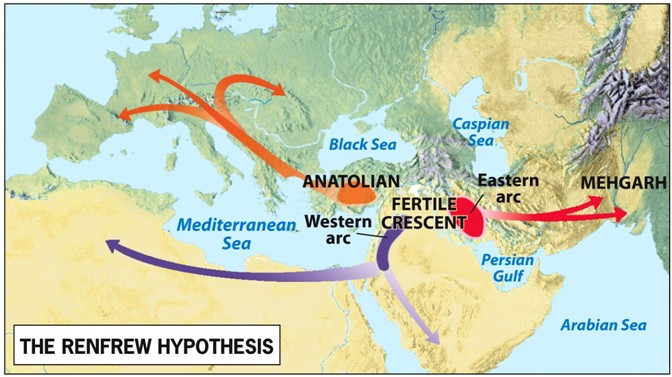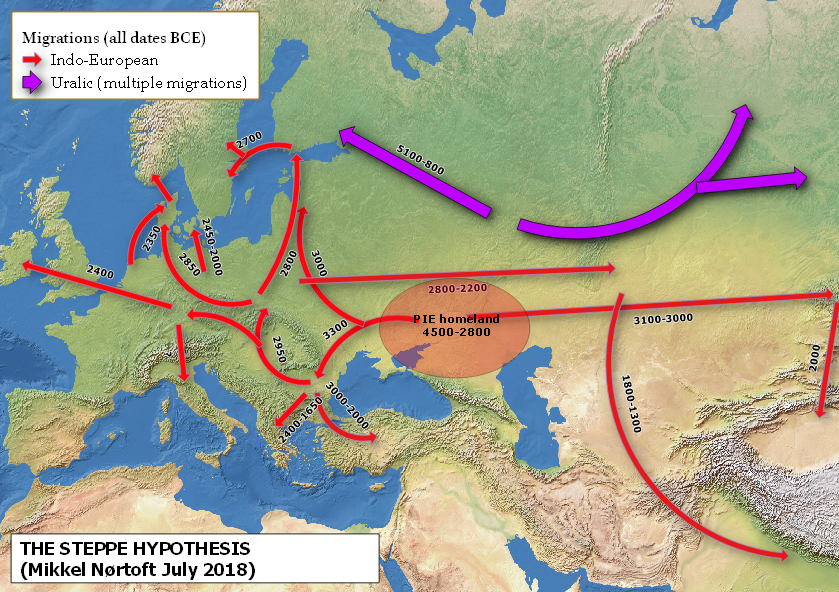The question of where and when Proto-Indo-European was spoken is often termed “the Indo-European homeland problem” and is closely related to the important follow-up questions “how and when did the languages spread”. If the members of this one language family have been so successful compared to other language families, and were already very widespread (from Tocharian in Western China and Sanskrit in India to Old Irish in Ireland, and Old Icelandic in Iceland) when they first appeared in written form, we would expect their initial spread to be somehow visible in the archaeological remains of prehistoric cultures. But of course spoken language normally flows elusively through the air and is not materialised unless written down, so the language spread could, in theory, be completely invisible, and determining a homeland would be close to impossible.
Nevertheless, many hypotheses about the Indo-European homeland have been put forward, but they were often “polluted” by nationalism (mostly placing the homeland in whichever writing scholar’s own country). The concept of Indo-Europeans was even taken hostage in the agenda of the Nazi regime, referring to them as “Aryans”. However, the term Aryan is actually a religious, cultural, and linguistic, but not racial(!), self-designation found in early Indic (Vedic) texts. This “hijack” by the Nazis has unfortunately tainted the topic of Indo-European studies to the public ever since. This does not, however, make the original homeland question any less relevant.
The two most persistent hypotheses for an Indo-European homeland are:
(1) The “Anatolian hypothesis”: the early speakers of Indo-European spread into Europe and central and southern Asia with the farming revolution from Anatolia (Turkey) around 6700 BCE

The Renfrew hypothesis. Unknown source (copied from Anne Wilcox at https://slideplayer.com/slide/8378552/)
(2) The “Pontic-Caspian steppe hypothesis”: the early speakers of Indo-European spread with herders from the grassland steppes north of, and between, the Black (“Pontic”) Sea and the Caspian Sea around 4000–3000 BCE.

The Steppe hypothesis. Mikkel Nørtoft, July 2018.
The “Anatolian hypothesis” has been dominant in most of western archaeology by Colin Renfrew, and the “Steppe hypothesis” has been dominant in most historical linguistic circles and in East European archaeology by Marija Gimbutas, and later elaborated and improved by James Mallory and David Anthony[1].
Mallory and Adams[2] have defined a set of general principles that work as argumentative tools using both linguistics and archaeology when trying to locate the homeland. I’ll mention two of the principles:
- The technological principle: What technological vocabulary can be securely reconstructed for PIE, and how does that match the material culture we are looking for archaeologically? Some important examples in PIE are terminology for wheels and wagons (including ‘axle’), weaving, wool, and dairy product terminology. Therefore we must expect the Indo-Europeans to have had these things at the time of PIE, or at least “Core PIE” (after the Anatolian branch split off). Interestingly, we have difficulty securely reconstructing agricultural terminology for PIE, which suggests that it was not very important in their society. Generally, it has been argued that the PIE vocabulary suggests that we should be looking for a patriarchal herding culture. If we look at the archaeological evidence for these things we find evidence of a herding culture in the Pontic-Caspian Steppes (many domestic animal bones from c. 5200 BCE onwards)[3], evidence for wheels from around 3500 BCE[4], evidence for the use of milk in pots from the mid 4th millennium BCE[5], and evidence for weaving (woven reed mats on ceramic imprints) from Khvalynsk on the Volga, probably around 4000 BCE[6]. However, no evidence of wool has been found in the steppes until the Catacomb period c. 2500 BCE;[7] but since wool is very rarely preserved anywhere, this is not a strong argument against the presence of wool (more on this in a later blog post). The best indication of wool in the steppes is a few wool textiles in Novosvobodnaya in the North Caucasus (neighbouring the steppes) C14-dated to 2893–2679 BCE[8].
- The relational principle: Loanwords are often exchanged between related and unrelated languages. When we see this in prehistory, it is a strong indication of direct contact between languages. Knowing the chains of sound laws, different chronological layers of loanword exchange (and then contact) can also be established to some degree. We can even see that several loanwords were exchanged between some North Caucasian languages (still spoken in the Caucasus region) and PIE before the split. A few early loans from an ancestor of the Semitic language family (Hebrew, Arabic, etc.), termed “Afro-Asiatic”, have also been proposed. One example is a word for ‘bull’, *tauros.[9]
Perhaps most important for the homeland question are the PIE loanwords borrowed into the common ancestor of the Uralic language family, which includes Finnish, Saami, Hungarian, and many minority languages in Russia. The Uralic “homeland” (equally debated) is by many scholars suggested to have been in the forest zone west of the Ural Mountains at the Volga–Oka (and perhaps also Kama) rivers, perhaps in the Volosovo culture (c. 3650–1900 BCE).[10]
These loanwords place PIE somewhere between the Uralic homeland (forests of Volga-Oka-(Kama)) and the Caucasus. Furthermore, many also argue for an even earlier unity between Uralic and Indo-European, termed Indo-Uralic. With all this in mind, a homeland in Anatolia would make it very difficult to explain the possible deep relationship between PIE and Proto-Uralic.
The lack of good reconstructions for agricultural words, especially for pulses (including lentils, beans, chickpeas and peas) speaks for the “Steppe hypothesis”. They are not found archaeologically in the steppe region in the relevant period, but they are found as domesticates with the early farmers of Anatolia from around 7000 BCE, and have been widespread in Europe ever since they arrived with early farmers from Anatolia. Therefore, it is unlikely that the Anatolian farmers spoke PIE, and it is yet another argument against the Anatolian hypothesis.[11]
In an upcoming post, we will look at the very new field of ancient DNA and its implications for the question of the Indo-European homeland.
[1] Mallory 1989; Anthony 2007
[2] Mallory and Adams 1997: 290–299; 2006: 444–453
[3] Anthony 2007: 174-181
[4] Anthony 2007: 298–299
[5] Mileto et al. 2018
[6] Shishlina 1999: 63, 81
[7] Shishlina et al. (Göteborg conference presentation)
[8] Shishlina et al. 2003; 2009; 2012
[9] Anthony 2007: 147
[10] Parpola 2012; Kallio 2015a
[11] Kroonen 2012; Anthony et al. 2016: 23–24
Literature
Anthony, David W. 2007. The horse, the wheel, and language. Princeton, NJ: Princeton University Press.
Anthony, D. W., D. R. Brown & O. D. Mochalov (eds.). 2016. A Bronze Age landscape in the Russian steppes: The Samara Valley Project (Monumenta Archaeologica 37). Los Angeles: UCLA Cotsen Institute of Archaeology Press.
Kallio, Petri 2015. The language contact situation in prehistoric Northeastern Europe. In: Robert Mailhammer, Theo Vennemann & Birgit Anette Olsen (eds.) The linguistic Roots of Europe: origin and development of European languages. Copenhagen: Museum Tusculanum Press.
Kroonen, Guus. 2012. Non-Indo-European root nouns in Germanic: evidence in support of the Agricultural Substrate Hypothesis. In: Riho Grünthal & Petri Kallio (eds.), A linguistic map of prehistoric Northern Europe (Suomalais-Ugrilaisen Seuran Toimituksia = Mémoires de La Société Finno-Ougrienne 266), 239–260. Helsinki: Société Finno-Ougrienne.
Mallory, James P. 1989. In search of the Indo-Europeans: language, archaeology and myth. London: Thames and Hudson.
Mallory, James P. & Douglas Q. Adams (eds). 1997. Encyclopedia of Indo-European culture. London & Chicago: Taylor & Francis.
Mallory, J.P. & Douglas Q. Adams 2006. The Oxford introduction to Proto-Indo-Indo-European and the Proto-Indo-European world. Oxford: Oxford University Press.
Mileto, Simona et al. 2018. Differing modes of animal exploitation in North-
Pontic Eneolithic and Bronze Age Societies. Star: Science & technology of archaeological research.
Parpola, Asko. 2012. Formation of the Indo-European and Uralic (Finno-Ugric) language families in the light of archaeology: Revised and integrated ‘total’ correlations. In: Riho Grünthal & Petri Kallio (eds.), A linguistic map of prehistoric Northern Europe (Suomalais-Ugrilaisen Seuran Toimituksia = Mémoires de La Société Finno-Ougrienne 266), 119–184. Helsinki: Société Finno-Ougrienne.
Shishlina, Natalia I. (ed.). 1999. Tekstil’ èpoxi bronzy Evrazijskix stepej [Bronze Age textiles of the Eurasian steppe]. Moskva: Gos. istoricheskij muzej.
Shishlina, Natalia I. et al. 2003. Bronze Age textiles from the North Caucasus: New evidence of fourth millennium BCE fibres and fabrics. Oxford Journal of Archaeology 22(4). 331–344.
Shishlina, Natalia I. et al. 2009. Paleoecology, subsistence, and 14C chronology of the Eurasian Caspian Steppe Bronze Age. Radiocarbon 51(2). 481-499.
Shishlina, Natalia I. et al. 2012. Isotopes, plants, and reservoir effects: Case study from the Caspian Steppe Bronze Age. Radiocarbon 54(3–4). 749–760.
Shishlina, Natalia I. et al. 2018. Presentation at the conference “When archaeology meets linguistics and genetics” at the University of Gothenburg, 2–4 May 2018.